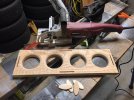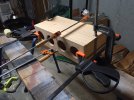20 years or thereabouts ago I built a small bookshelf loudspeaker from Visaton units in an passive radiator config ( AL130 midwoofer) in solid birch. They were drop dead gorgeous, with heavy radius all around 25 or 30 mm thick walls, professionally made by a small kitchen and wc cabinet maker to furniture grade standard. He assured me the wood would be perfectly dry and wouldn't budge, got it treated/lackered inside and out for ease of mind, plus bituminous sheets lining the inside.You know where this is going...they were always in my living room, subjected to little temperature and moist variation, but after some 7 or 8 years the humitidy that somehow had crept in and out, caused too much of different expansion rates along the wood grain (unavoidable) and too much stress accumulated and the whole thing begun to disjoint...Don't do it, or get Sonus Faber to do it for you if you must, I tried to be as carefull as I could and got burned...( then again, I didn't build them myself...)
Thanks for sharing that. Unfortunately I have 4/4 walnut and 8/4 Brazilian cherry (aka tigerwood) sitting in my apartment coming to moisture equilibrium, so the die is cast. I think my approach is going to be to 1. consult with some local cabinetmakers, as making boxes isn't exactly a new thing and they might know tricks that work and 2. really pay attention to surface treatment.
I did find one builder online who had speaker cabinets produce small cracks after moving from a dry climate to a humid coastal climate. He provided pictures (sorry don't have the link handy) and was able to repair by injecting epoxy, so some small cosmetic damage but not terrible result.
Just to summarize, I wasn't able to find any data that solid hardwood is worse than MDF in acoustic terms. I appreciate your advice and I'm going to steer in the direction of taking whatever mitigating steps I can.
So here is a strange case: I've owned a couple of small sailboats: J30 with teak rub rails and hand rails, 26' Columbia with custom teak cockpit seats, and a 1960's Lightning with mahogany, ash, and mahogany plywood decks (entirely wood construction). All three boats were exposed to marine environment, dry stored in winter New England climate, basically put through a torture test for years. Result: no cracking or failed joints. What's going on there?
Teak is a very resin rich wood (as is Brazilian cherry), so that is part of the story. Mahogany and ash are not.
What was your failure? Joints failing? Cracks across panels? What adhesive was used on the joints, do you know? Thx.


